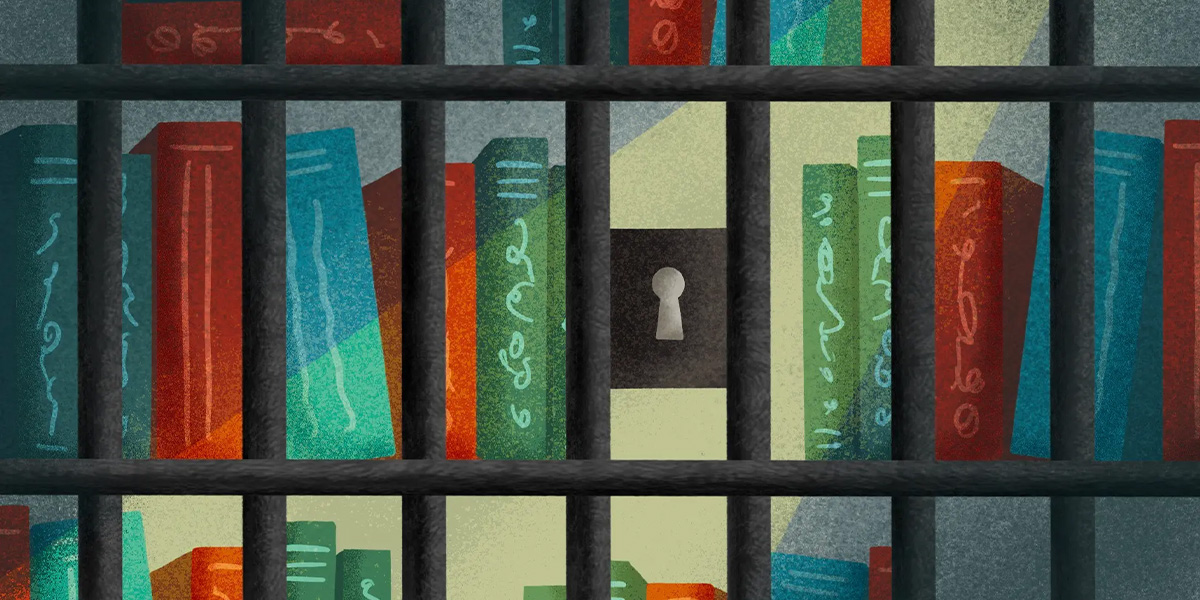Expert Contributes to First Update in American Library Association Standards Since 1992

A UMD library researcher helped create the first update to nationwide guidelines on jail and prison libraries in 32 years; they add new guidance on accessibility, among other measures designed to maximize the facilities' benefit to incarcerated people. Illustration by Valerie Morgan.
Twice a year, staff members from the Eric Carle Museum of Picture Book Art visit the 190-person Franklin County Jail in rural western Massachusetts for an unusual literary project: They teach incarcerated residents a method of reading aloud that encourages kids to be active participants in story time. Then, the incarcerated parents who participate in the workshop choose a picture book and send home a video of themselves reading it to the camera.
“My two beautiful daughters loved it,” said one. “It made them super happy to actually see me reading a book to them rather than just hear my voice.”
Just five years ago, there was essentially zero library programming in the Franklin County Jail. In 2019, when Chelsea Jordan-Makely became head librarian of the local Griswold Memorial Library, she began working with the warden to bring books and services to the people in the jail. “There are all of these mandates that say we have a responsibility to provide library services for the incarcerated, but historically we’ve been falling very short,” she said.
That could soon change following the first update to nationwide guidelines on jail and prison libraries in 32 years, written in part by a University of Maryland researcher. Victoria Van Hyning, assistant professor of library innovation at the College of Information, was an editor and project manager on the American Library Association’s (ALA) “Standards for Library Services for the Incarcerated or Detained,” the document released last month that guides how carceral and detention libraries should function—the first update to the guidelines since 1992.
“We’ve got a lot of catching up to do,” said Van Hyning. “We’re hoping this really gives people an advocacy tool.”
The ALA regularly releases guidelines on a range of library-related topics, including academic libraries, audio-visual materials and genealogical research. Typically, said Van Hyning, these are updated every five years or so, but in 2021, several ALA members noticed that the standards for prison libraries were long outdated. They put out calls for researchers who were interested in updating the publication, and Van Hyning, whose professional interests include library accessibility, joined the team.
Incarcerated people’s right to library access was enshrined in 2015 in the United Nations Office on Drugs and Crime’s Standard Minimum Rules for the Treatment of Prisoners (known as the Nelson Mandela Rules). Researchers and incarcerated people report that visiting prison libraries can improve technical skills, reduce stress and depression, and build social cohesion among the population, which numbers about 2 million in the U.S.
“Reading can allow you to escape the realities of prison mentally and emotionally,” an incarcerated person told Freedom Reads, an organization founded by poet, lawyer and prison reform advocate Reginald Dwayne Betts ’09 that opens libraries in prisons. “We may be physically imprisoned, but through a book, we can … find hope through the storytelling of someone else’s story or through a character in a book.”
Many incarcerated people don’t get those benefits, said Jordan-Makely. “The prison library exists in every American’s mind because of what we’ve seen in movies and television, but that’s so far from the reality,” she said. “For many facilities, just having a pile of old books in the corner constitutes a library.”
Van Hyning and her four co-leads on the project (two of whom spent time in prison) began by examining the 1992 standards, finding that sections on materials, facilities and staffing “largely needed to be updated, but were really useful jumping-off points,” she said.
Widely absent from the standards was guidance on accessibility. Prisons tend to have a high special-needs population, Van Hyning said, including people with physical disabilities or traumatic brain injuries, and those who read below age level. The new standards, for example, provide suggestions on the turning radius between stacks for those in wheelchairs and offer a range of video and audio resources for people with print disabilities.
The standards also include 23 case studies where new programming made a difference in jails and prisons, from writing classes during National Poetry Month to expanding library access to include family members of the incarcerated. “A lot of people don’t know that libraries are free in the general public, so we’re trying to raise awareness that these are free resources and connective tissue for your family when they’re outside” prison, said Van Hyning.
Last year, members of Congress from Texas, Ohio and Missouri introduced the Prison Libraries Act, which would give state prisons $60 million over six years to bolster their library services and resources. Van Hyning hopes that the act, which has yet to go before Congress, along with the new standards, will usher in a new age for prison libraries.
“There’s an almost immeasurable impact when people have free access to information,” she said.
The original article was written by Sala Levin and published by Maryland Today on October 3, 2024.